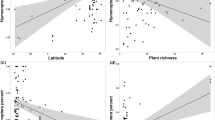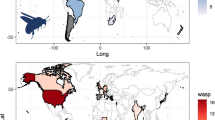Abstract
This study aims to determine whether a significant decrease in airborne concentrations of Ambrosia pollen witnessed in the north-west of the Province of Milan in Northern Italy could be explained by environmental factors such as meteorology, or whether there is evidence to support the hypothesis that the decrease was related to the presence of large numbers of the oligophagous Ophraella communa leaf beetles that are used as a biological control agent against Ambrosia in other parts of the world. Airborne concentrations of Ambrosia, Cannabaceae and Urticaceae pollen data (2000–2013) were examined for trends over time and correlated with meteorological data. The amount of Ambrosia pollen recorded annually during the main flowering period of Ambrosia (August–September) was entered into linear regression models with meteorological data in order to determine whether the amount of airborne Ambrosia pollen recorded in 2013 was lower than would normally be expected based on the prevailing weather conditions. There were a number of significant correlations between concentrations of airborne Ambrosia, Cannabaceae and Urticaceae pollen, as well as between airborne pollen concentrations and daily and monthly meteorological data. The linear regression models greatly overestimated the amount of airborne Ambrosia pollen in 2013. The results of the regression analysis support the hypothesis that the observed decrease in airborne Ambrosia pollen may indeed be related to the presence of large numbers of O. communa in the Milan area, as the drastic decrease in airborne Ambrosia pollen in 2013 cannot be explained by meteorology alone.




Similar content being viewed by others
References
Baskin, J. M., & Baskin, C. C. (1977). Dormancy and germination in seeds of common ragweed with reference to Beal´s buried seed experiment. American Journal of Botany, 64, 1174–1176.
Baskin, J. M., & Baskin, C. C. (1980). ecophysiology of secondary dormancy in seeds of Ambrosia artemisiifolia. Ecology, 3, 475–480.
Bickel, R. (2012). Multilevel analysis for applied research: It’s just regression! (Methodology in the social sciences). New York: Guilford Press.
Bosio, G., Massobrio, V., Chersi, C., Scavarda, G., & Clark, S. (2014). Spread of the ragweed leaf beetle, Ophraella communa LeSage, 1986 (Coleoptera Chrysomelidae), in Piedmont Region (Northwestern Italy). Bollettino della Società Entomologica Italiana, 146(1), 17–30.
Cockshull, K. E., & Kofranek, A. M. (1994). High night temperatures delay flowering, produce abnormal flowers and retard stem growth of cut-flower chrysanthemums. Scientia Horticulturae, 56, 217–234.
Comtois, P. (1998). Statistical analysis of aerobiological data. In Mandrioli, P., Comtois P. and V. Levizzani (eds.) Methods in aerobiology. Italy: Pitagora Editrice Bologna.
Cox, C. S. & Wathes, C. M. (1995). Bioaerosols handbook. USA: Lewis Publishers.
Dahl, Å., Galán, C., Hajkova, L., Pauling, A., Sikoparija, B., Smith, M., et al. (2013). The onset, course and intensity of the pollen season. In M. Sofiev & K.-C. Bergmann (Eds.), Allergenic Pollen (pp. 29–70). Netherlands: Springer.
Dahl, A., Strandhede, S.-O., & Wihl, J.-A. (1999). Ragweed—An allergy risk in Sweden? Aerobiologia, 15(4), 293–297.
Essl, F., Dullinger, S., & Kleinbauer, I. (2009). Changes in the spatio-temporal patterns and habitat preferences of Ambrosia artemisiifolia during its invasion of Austria. Preslia, 81(2), 119–133.
Fumanal, B., Chauvel, B., & Bretagnolle, F. (2007). Estimation of pollen and seed production of common ragweed in France. Annals of Agricultural and Environmental Medicine, 14, 233–236.
Futuyma, D. J., Keese, M. C., & Scheffer, S. J. (1993). Genetic constraints and the phylogeny of insect-plant associations: responses of Ophraella communa (Coleoptera: Chrysomelidae) to host plants of its congeners. Evolution, 47(3), 888–905.
Futuyma, D. J., & MCCafferty, S. S. (1990). Phylogeny and the evolution of host plant associations in the leaf beetle genus Ophraella (Coleoptera, Chrysomelidae). Evolution, 44, 1885–1913.
Gerber, E., Schaffner, U., Gassmann, A., Hinz, H. L., Seier, M., & Müller-Schärer, H. (2011). Prospects for biological control of Ambrosia artemisiifolia in Europe: Learning from the past. Weed Research, 51(6), 559–573.
Guo, J.-Y., Zhou, Z.-S., Zheng, X.-W., Chen, H.-S., Wan, F.-H., & Luo, Y.-H. (2011). Control efficiency of leaf beetle, Ophraella communa, on the invasive common ragweed, Ambrosia artemisiifolia, at different growing stages. Biocontrol Science and Technology, 21(9), 1049–1063.
Hirst, J. M. (1952). An automatic volumetric spore trap. The Annals of Applied Biology, 39(2), 257–265.
Meng, L., & Li, B. (2005). Advances on biology and host specificity of the newly introduced beetle, Ophraella communa Lesage (Coleoptera: Chrysomelidae), attacking Ambrosia artemisiifolia (Compositae) in continent of China. Chinese Journal of Biological Control, 21(2), 65–69.
Müller-Schärer, H., Lommen, S. T. E., Rossinelli, M., Bonini, M., Boriani, M., Bosio, G., et al. (2014). Ophraella communa, the ragweed leaf beetle, has successfully landed in Europe: Fortunate coincidence or threat? Weed Research, 54(2), 109–119.
Ordinanza_Del_Presidente_Della_Regione_Lombardia (1999). O.P.G.R. 29 marzo 1999—n. 25522. Ordinanza contingibile e urgente ai sensi dell’art. 32 della legge 23 dicembre 1978, n.833. Disposizioni contro la diffusione della pianta Ambrosia nella Regione Lombardia al fine di prevenire la patologia allergica ad essa correlata: Bolletino Ufficiale della Regione Lombardia. Serie Ordinaria N.15, 12 aprile 1999.
Pallant, J. (2001). SPSS survival manual. Maidenhead: Open University Press.
Palmer, W. A., & Goeden, R. D. (1991). The host range of Ophraella communa Lesage (Coleoptera: Chrysomelidae). Coleopterists Bulletin, 45, 115–120.
Pickett, S. T., & Baskin, J. M. (1973). The role of temperature and light in the germination behaviour of Ambrosia artemisiifolia. Torrey Botanical Society, 100, 165–170.
Prentović, M., Radišić, P., Smith, M., & Šikoparija, B. (2014). Predicting walnut (Juglans spp.) crop yield using meteorological and airborne pollen data. Annals of Applied Biology In press.
Regione_Lombardia (2013). Prevenzione delle allergopatie da ambrosia in Lombardia.
Rogers, C., Wayne, P. M., Macklin, E. A., Muilenberg, M. L., Wagner, C. J., Epstein, P. R., et al. (2006). Interaction of the onset of spring and elevated atmospheric CO2 on ragweed (Ambrosia artemisiifolia L.) pollen production. Environmental Health Perspectives, 114(6), 865–869.
Skjøth, C. A., Smith, M., Sikoparija, B., Stach, A., Myszkowska, D., Kasprzyk, I., et al. (2010). A method for producing airborne pollen source inventories: An example of Ambrosia (ragweed) on the Pannonian Plain. Agricultural and Forest Meteorology, 150, 1203–1210.
Smith, M., Cecchi, L., Skjoth, C. A., Karrer, G., & Sikoparija, B. (2013). Common ragweed: A threat to environmental health in Europe. Environment International, 61, 115–126.
Stach, A., Smith, M., Prieto Baena, J. C., & Emberlin, J. (2008). Long-term and short-term forecast models for Poaceae (grass) pollen in Poznań, Poland, constructed using regression analysis. Environmental and Experimental Botany, 62, 323–332.
Sterling, M., Rogers, C., & Levetin, E. (1999). An evaluation of two methods for microscopic analysis of airborne fungal spore concentrations from the Burkard spore trap. Aerobiologia, 15, 9–18.
Takizawa, H. A., Saito, A., Sato, K., Hirano, Y., & Ohno, M. (1999). Invading insect, Ophraella communa LeSage, 1986. Range expansion and life history in Kanto District, Japan. Gekkanlushi, 338, 26–31.
Tanaka, K., & Yamanaka, T. (2009). Factors affecting flight activity of Ophraella communa (Coleoptera: Chrysomelidae), an exotic insect in Japan. Environmental Entomology, 38(1), 235–241.
Teshler, M. P., Ditommaso, A., Gagnon, J. A., & Watson, A. K. (2002). Ambrosia artemisiifolia L., common ragweed (Asteraceae). In J. T. Huber (Ed.) Biological control programmes in Canada New York (pp. 290–294), USA CABI Publishing.
Wan, F.-H., Guo, J.-Y. & Zhang, F. (2009). Research on biological invasions in China. Beijing: Science press.
Willemsen, R. W. (1975). Effect of stratification temperature and germination temperature on germination and induction of secondary dormancy in common ragweed seeds. American Journal of Botany, 62, 1–5.
Yamamura, K., Moriya, S., Tanaka, K., & Shimizu, T. (2007). Estimation of the potential speed of range expansion of an introduced species: characteristics and applicability of the gamma model. Population Ecology, 49(1), 51–62.
Zhou, Z.-S., Chen, H.-S., Zheng, X.-W., Guo, J.-Y., Guo, W., Li, M., et al. (2014). Control of the invasive weed Ambrosia artemisiifolia with Ophraella communa and Epiblema strenuana. Biocontrol Science and Technology, 24(8), 950–964.
Zhou, Z.-S., Guo, J.-Y., Chen, H.-S., & Wan, F.-H. (2010a). Effect of humidity on the development and fecundity of Ophraella communa (Coleoptera: Chrysomelidae). BioControl, 55(2), 313–319.
Zhou, Z.-S., Guo, J.-Y., Chen, H.-S., & Wan, F.-H. (2010b). Effects of temperature on survival, development, longevity, and fecundity of Ophraella communa (Coleoptera: Chrysomelidae), a potential biological control agent against Ambrosia artemisiifolia (Asterales: Asteraceae). Environmental Entomology, 39(3), 1021–1027.
Zhou, Z.-S., Guo, J.-Y., Zheng, X.-W., Luo, M., Chen, H.-S., & Wan, F.-H. (2011). Reevaluation of biosecurity of Ophraella communa against sunflower (Helianthus annuus). Biocontrol Science and Technology, 21(10), 1147–1160.
Zhu, D. H., Zhu, J., Peng, Z. P., & Wan, F. H. (2012). Effects of photoperiod and temperature on reproductive diapause in Ophraella communa (Coleoptera: Chrysomelidae), a potential biocontrol agent against Ambrosia artemisiifolia. Insect Science, 19(3), 286–294.
Acknowledgments
We acknowledge support from EU COST Action FA1203 “Sustainable management of Ambrosia artemisiifolia in Europe (SMARTER)” (http://ragweed.eu). This work was partly financed by the Ministry of Science, Republic of Serbia (project numbers OI173002 and III43002) and the COST-STSM-FA1203-16674 to BS. The authors are grateful to Dott. Marina della Foglia, responsible of the UOC SPreSAL of the Local Health Authority Milan 1 and to Mrs. Marilena Pisoni for providing information about construction sites in the study area.
Author information
Authors and Affiliations
Corresponding author
Rights and permissions
About this article
Cite this article
Bonini, M., Šikoparija, B., Prentović, M. et al. Is the recent decrease in airborne Ambrosia pollen in the Milan area due to the accidental introduction of the ragweed leaf beetle Ophraella communa?. Aerobiologia 31, 499–513 (2015). https://doi.org/10.1007/s10453-015-9380-8
Received:
Accepted:
Published:
Issue Date:
DOI: https://doi.org/10.1007/s10453-015-9380-8




